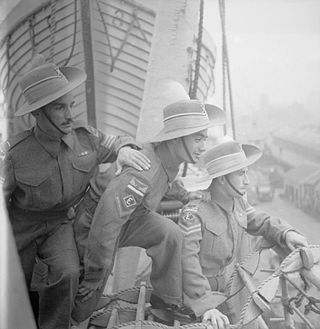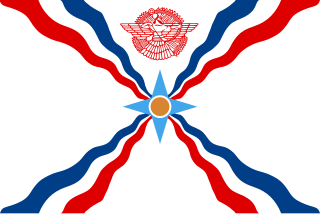
The Sayfo, also known as the Seyfo or the Assyrian genocide, was the mass slaughter and deportation of Assyrian/Syriac Christians in southeastern Anatolia and Persia's Azerbaijan province by Ottoman forces and some Kurdish tribes during World War I.

Petros Elia of Baz, better known as Agha Petros, was an Assyrian military leader during World War I.

Hakkari, was a historical mountainous region lying to the south of Lake Van, encompassing parts of the modern provinces of Hakkâri, Şırnak, Van in Turkey and Dohuk in Iraq. During the late Ottoman Empire it was a sanjak within the old Vilayet of Van.

The Assyrian Levies were the first Iraqi military force established by the British in British controlled Iraq. The Iraq Levies originated in a local armed scout force raised during the First World War. After Iraq became a British Mandate, the force was composed mostly of Assyrians, Kurds and Iraqi Turkmen who lived in the north of the country, while the nascent Iraqi Army was recruited first from the Arabs who had joined the Iraqi Levies and later from the general Arab population (Beth-Kamala). Eventually the Levies enlisted mainly Assyrian soldiers with British officers. The unit initially defended the northern frontiers of the Province of Mosul when Turkey claimed the province and massed its army across the frontiers. After 1928 the prime role of the Levies was to guard the Royal Air Force bases located in Iraq.

The Assyrian independence movement is a political movement and ethno-nationalist desire of ethnic Assyrians to live in their indigenous Assyrian homeland in northern Mesopotamia under the self-governance of an Assyrian State.

Tyari is an Assyrian tribe and a historical district within Hakkari, Turkey. The area was traditionally divided into Upper and Lower Tyari –each consisting of several Assyrian villages. Both Upper and Lower Tyari are located on the western bank of the Zab river. Today, the district mostly sits in around the town of Çukurca. Historically, the largest village of the region was known as Ashitha. According to Hannibal Travis the Tyari Assyrians were known for their skills in weaving and knitting.

Malik Khoshaba Yousip was an Assyrian tribal leader of the Tyari tribe who played a significant role in the Assyrian independence movement during World War I.

The Simko Shikak revolt refers to an armed Ottoman-backed tribal Kurdish uprising against the Qajar dynasty of Iran from 1918 to 1922, led by Kurdish chieftain Simko Shikak from the Shekak tribe.

Ahmed Barzani revolt refers to the first of the major Barzani revolts and the third Kurdish nationalistic insurrection in modern Iraq. The revolt began in 1931, after Ahmed Barzani, one of the most prominent Kurdish leaders in southern Kurdistan, succeeded in unifying a number of other Kurdish tribes. The ambitious Kurdish leader enlisted a number of Kurdish leaders into the revolt, including his young brother Mustafa Barzani, who became one of the most notorious commanders during this revolt. The Barzani forces were eventually overpowered by the Iraqi Army with British support, forcing the leaders of Barzan to go underground.
1926 Simko Shikak revolt refers to a short-timed Kurdish uprising against the Pahlavi dynasty of Iran in 1926, led by Kurdish chieftain Simko Shikak from Shikak tribe.

Çığlı is a village in Hakkâri Province in southeastern Turkey. It is located in the district of Çukurca District and the historical region of Hakkari.

The Assyrian rebellion was an uprising by the Assyrians in Hakkari which was administered by Assyrians at the time. It began in July 1924 and ended on 28 September that same year. This was the first rebellion in the newly formed Republic of Turkey. After the rebellion ended, 8,000 Assyrians were deported into Mandatory Iraq.

The Defence of Iwardo was a military engagement between Ottoman authorities and Assyrian defenders led by Gallo Shabo in 1915, during the Assyrian genocide. The pockets of resistance during the Assyrian genocide was named "Midyat Rebellion" after Midyat, the largest Assyrian town in Tur Abdin by the Ottoman authorities.

The village of Azakh was one of the few remaining pockets of resistance during the Sayfo that the Ottoman authorities called the "Midyat Rebellion" named after Midyat, the largest Aramean town in Tur Abdin.

The Assyrian volunteers were an ethnic Assyrian military force during WW1, led mainly by General Agha Petros Elia of Baz and several tribal leaders known as Maliks under the spiritual leadership of the Catholicos-Patriarch Mar Shimun Benyamin allied with the Entente Powers described by the English pastor and author William A. Wigram as Our Smallest Ally.

The Battle of Charah or Charah Expedition took place between the Assyrian Volunteers led by Agha Petros and Malik Khsoshaba against Shekak tribesmen led by Simko Shikak in revenge for the assassination of Mar Benyamin Shimun by Simko. Simko Shikak, who was responsible for the murder of the Assyrian patriarch Mar Shimun was staying in the fortress. The fortress had never been conquered despite numerous attempts by the Iranian government.

Dawid Mar Shimun was an Assyrian military leader From World War I up until the Simele Massacre in 1933 when he was exiled to Cyprus along with his son Mar Eshai Shimun. His first hand experience and contribution during the years leading up to the family's exile to Cyprus in 1933 cannot be overlooked, for his presence was common place beside the Patriarchs and his sister, Lady Surma.

Malik Yaqo Ismail (February 12, 1894 - January 25, 1974, was an Assyrian tribal leader who was a Malik of the Upper Tyari tribe and a military leader of the Assyrian Levies.

The Battle of Suldouze was a military engagement between the Assyrian Volunteers led by Agha Petros And the Ottoman soldiers led by Kheiri Bey who were stationed in Suldouze. 1500 Assyrian horsemen overcame the far larger Ottoman force of over 8000.
The Hakkari Expedition of 1916 was a number of raids conducted by the Assyrian volunteers against local Hakkari Kurdish tribesmen who the year prior, with the help of the Ottomans expelled the Assyrians from Hakkari and resulted in them settling in Russian controlled Urmia and its surroundings.

















